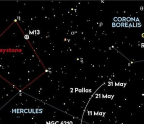Artemis takes aim at the MOON

Back in 2019, the year of the 50th anniversary of the Apollo lunar human space programme, Jim Bridestine, then NASA Administrator announced details of Project Artemis and with it the commitment to a single monumental goal: to establish a permanent human Moon base. With the project costing an estimated $93 billion by 2025, NASA’s first milestone in this programme is the Artemis I mission, which is due to launch from Kennedy Space Center in mid 2022.
A four-week return mission to the Moon, Artemis I will be the first integrated test flight of NASA’s Deep Space Exploration System, which includes the Orion spacecraft, Space Launch System (SLS) rocket and the Exploration Ground Systems (EGS) at Kennedy Space Center. There will be no lunar landing for Artemis I, but it will lay the foundation for the future Artemis missions to build on.

The Artemis spacecraft has a launch window of two weeks every month when the
You’re reading a preview, subscribe to read more.
Start your free 30 days





